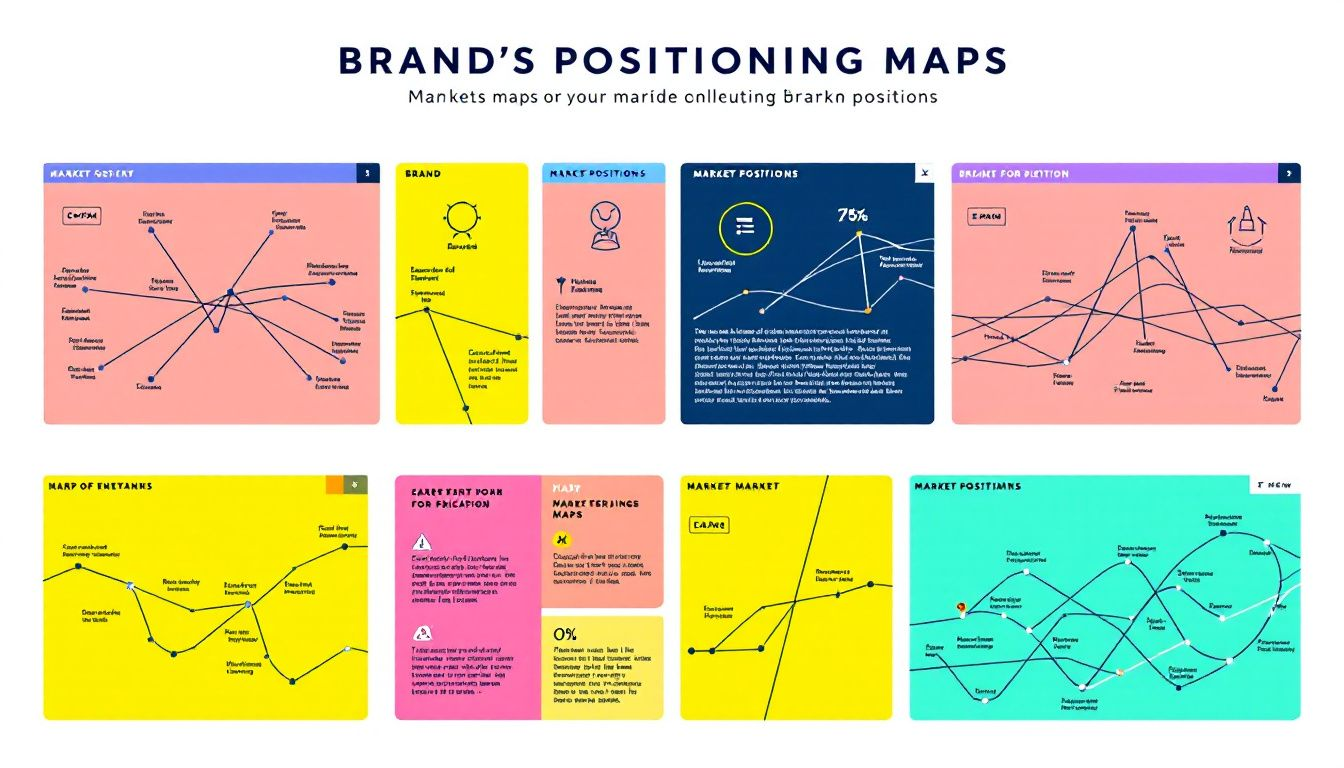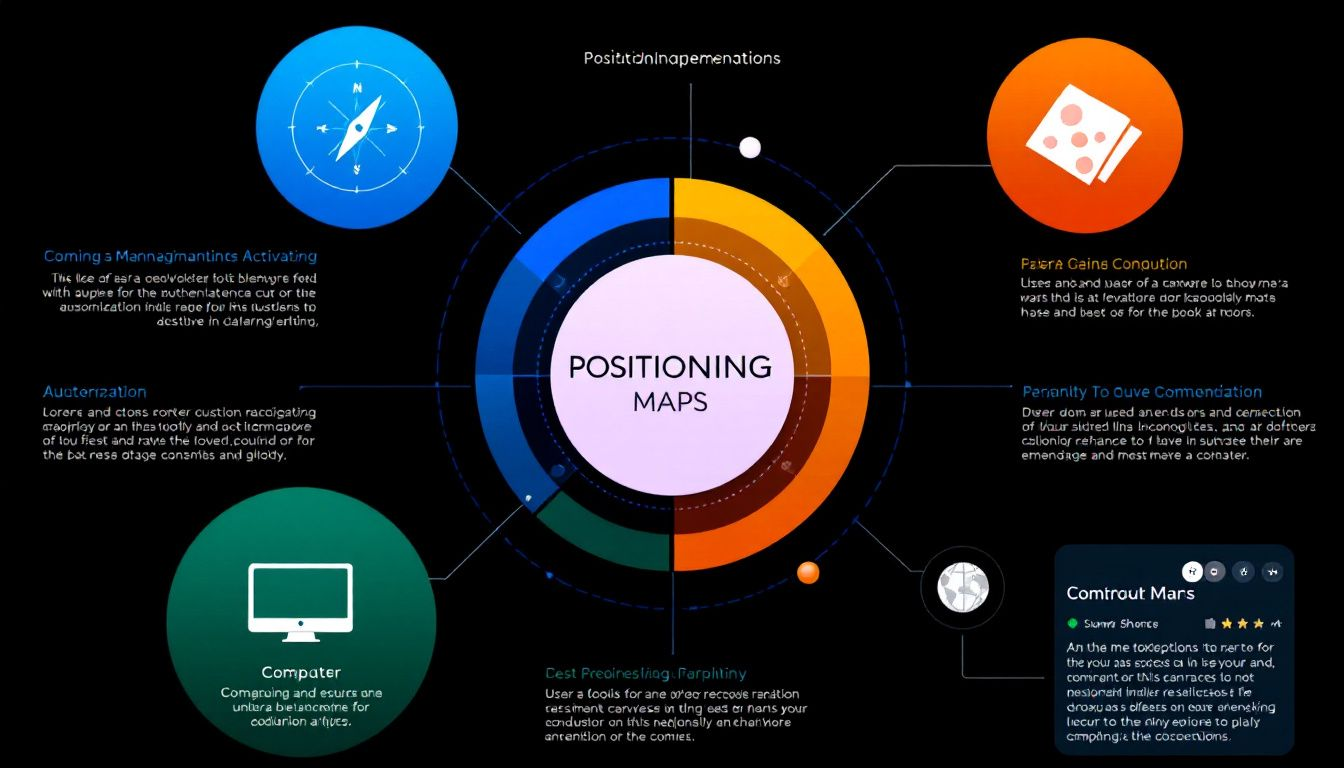How to Create the Best Positioning Map for Your Brand
Enhance your brand's impact with effective positioning strategies. Discover practical tips for mastering your positioning map. Read the article now!

A positioning map is a visual tool that shows where your product stands compared to competitors based on key attributes like price and quality. It helps identify market gaps and offers insights for strategic planning. This article explains how to create and use a positioning map to strengthen your brand’s market position.
Key Takeaways
- Positioning maps are vital for visualizing market positions and identifying competitive gaps, guiding brands to refine their strategies for success.
- Creating an effective positioning map involves defining clear objectives, selecting relevant attributes, and thoroughly analyzing competitors to visualize unique market opportunities.
- Regular updates and customer feedback are essential to keep positioning maps relevant, allowing brands to adapt and stay ahead of market dynamics.
Understanding Positioning Maps

Positioning maps are visual representations that illustrate a product’s place in the market, clarifying how it stands out from competitors. The primary aim is to uncover white space opportunities and guide strategic decisions, helping businesses carve out a unique market position. These maps offer a snapshot of the competitive landscape, clarifying a brand’s current position and potential growth paths.
The axes on a positioning map represent attributes such as price, features, and quality, which are crucial for differentiating brands. A well-constructed perceptual map highlights the relevant industry attributes that affect consumer perceptions, making it an invaluable tool for any marketer looking to gain a competitive edge.
Types of Positioning Maps
There are several types of positioning maps, each serving unique analytical purposes. Two-dimensional perceptual maps are the most common, using two key attributes to visually represent customer perceptions. These maps are straightforward and effective for illustrating simple comparisons between brands or products.
For a more comprehensive analysis, multi-dimensional perceptual maps come into play. These maps incorporate various attributes, providing a nuanced view of the market landscape.
Feature or benefit-based maps, on the other hand, emphasize consumer value propositions and are grounded in data, offering insights into how different features or benefits affect consumer decisions.
Importance of Positioning Maps in Marketing

Positioning maps play a significant role in marketing by highlighting positioning gaps in the market, revealing areas with lower competition. This visualization helps brands identify the right gaps to target, ensuring their strategies are aligned with market opportunities. Perceptual maps enable brands to visualize competitors’ market positions and customer perceptions, aiding strategic marketing decisions.
For instance, brands can use perceptual maps to gain insights into customer preferences and market positioning. These maps can illustrate consumer perceptions of snack brands based on attributes like healthiness and taste, guiding targeted marketing strategies. They also help brands differentiate themselves in a competitive landscape by identifying their unique standing in the marketplace.
Overall, positioning maps are invaluable for marketers looking to achieve a competitive advantage. They assist in determining how to differentiate a brand and highlight areas where a brand can stand out. Regular updates to these maps reflecting changes in market dynamics and competitor strategies help businesses stay ahead.
Steps to Create a Positioning Map
Creating a positioning map involves several critical steps. From defining your objectives to choosing relevant attributes, identifying competitors, gathering data, plotting the map, and finally analyzing and interpreting the results, each step is integral to developing a comprehensive and accurate map.
Let’s walk through these steps in detail to ensure your positioning map is both effective and insightful.
Define Your Objectives
The first step in creating a positioning map is to define your objectives. Clearly defined objectives guide the development of the map and ensure it serves its intended purpose. These objectives act as a roadmap for decision-making, helping you align your strategies with market expectations and customer needs.
Understanding customer needs is crucial for setting these objectives. Aligning your positioning map objectives with your target audience’s values allows you to fine-tune your approach to meet their expectations and enhance customer satisfaction.
Choose Relevant Attributes
Selecting the right attributes for your positioning map is essential, as they directly influence how consumers perceive your brand. The axes of the map should represent attributes that are significant to your target audience. Commonly chosen attributes include price, features, quality, and other criteria that are important to consumers.
Prioritizing attributes that customers care about ensures that your positioning map accurately reflects market dynamics and consumer perceptions. This step is critical in creating a map that provides valuable insights into how your brand is positioned relative to competitors.
Identify Competitors
Understanding both direct and indirect competitors is vital for accurately positioning your brand in the market. To enhance analysis, it is recommended to include at least 10 competitors when positioning a new brand. This comprehensive list helps you understand the competitive landscape and identify market gaps.
Surveys or interviews can be effective techniques to gather information on competitors. Plotting 7–10 brands on your positioning map provides a comprehensive view of the market, ensuring your product stands out.
Gather Data
Collecting diverse data sources is crucial to ensure that your positioning map is based on comprehensive insights into market dynamics and consumer preferences. Employing methods such as focus groups and surveys can provide valuable feedback from potential customers, enhancing the accuracy of your map.
Using a scoring system to evaluate different attributes can help quantify consumer perceptions and make the data more actionable. This step lays the foundation for an accurate and insightful positioning map that reflects real market conditions.
Plot the Map
To plot the map, start by creating four quadrants using a vertical line and horizontal lines for your X-axis and Y-axis. Label the axes and name each quadrant to stay organized. Plot each product on the positioning map to visualize their positions in the marketplace.
It’s beneficial to add your brand last to view the competitive landscape first and accurately position your brand. If the initial map does not reveal valuable insights, repeat the steps focusing on alternative attributes to refine the map.
Analyze & Interpret Results
Analyzing the positioning map involves developing a scoring system for each axis to quantify competitors’ performance on different attributes. This detailed analysis can reveal strategic insights about market opportunities and brand performance.
For axes consisting of different features, a weight system or another scoring method is required to effectively evaluate performance. This analysis helps anticipate competitors’ market moves and develop counter-strategies.
Utilizing competitor feedback from surveys or interviews offers a deeper understanding of their strengths and weaknesses, informing strategic decisions. This step ensures that your positioning map remains a dynamic tool for continuous improvement.
Real-World Examples of Positioning Maps

Positioning maps are widely used in various fields, including marketing, customer service, and product management. These maps visually represent a brand’s position relative to its competitors using specific attributes, making them invaluable for strategic planning. A brand positioning map is an essential tool in this process.
Regular updates to the positioning map are crucial to reflect changes in market dynamics and the actual position of competitor strategies.
Case Study: Marketing Campaigns
Positioning maps play a crucial role in identifying market gaps and shaping marketing strategies. For instance, successful campaigns by brands like Brand X and Brand Y have effectively leveraged positioning maps to enhance their brand visibility and market share. These maps allow brands to clearly see their competitors’ strengths and weaknesses in the market.
These maps help brands tailor their marketing efforts by understanding customer perceptions and preferences. For example, a brand targeting health-conscious consumers can use a positioning map to highlight its product’s health benefits compared to competitors. This strategic approach aligns closely with customer needs and desires, ensuring the brand stands out in the competitive landscape.
Case Study: New Product Launches
Perceptual maps provide valuable insights during new product launches by offering a strategic overview of market reception based on attributes like innovation and price. These maps can indicate potential reception by positioning these attributes against competitors. For instance, a company launching a tech product can use a perceptual map to identify unoccupied market spaces, targeting less competitive areas.
Analyzing consumer perceptions and competitor products helps businesses create a unique value proposition that sets their product apart. This approach not only guides strategic decisions but also helps in crafting marketing messages that resonate with potential customers.
Tools for Creating Positioning Maps

Several tools are available for creating positioning maps, making the process easier and more efficient. For instance, Milanote helps in organizing various types of content, including notes and multimedia, facilitating the creation of visual maps. This tool is particularly useful for visual thinkers who prefer a flexible, collaborative workspace.
Using templates for positioning maps can streamline the process, especially for those new to brand mapping. These templates provide a structured approach, ensuring all necessary elements are included and the map is clear and actionable.
Best Practices for Effective Positioning Maps
Effective positioning maps ensure that a business evolves in line with customer expectations. Regularly updating the map to reflect changes in market dynamics and competitor strategies is essential for maintaining its relevance. Staying attuned to customer needs and market trends allows businesses to continuously refine their positioning and stay ahead of the competition.
Incorporating feedback from customers and competitors can provide valuable insights into areas of improvement and new opportunities. This proactive approach ensures that your positioning map remains a powerful tool for strategic decision-making.
Summary
In conclusion, positioning maps are indispensable tools for understanding and navigating the competitive landscape. By defining clear objectives, choosing relevant attributes, and conducting thorough competitive analysis, businesses can create accurate and insightful maps that guide strategic decisions. Regular updates and incorporating feedback ensure these maps remain relevant and effective.
Embrace the power of positioning maps to transform your strategic approach. With the insights gained from these maps, you can carve out a unique market position, uncover new opportunities, and achieve sustained success.
Frequently Asked Questions
What is the primary purpose of a positioning map?
A positioning map helps you visualize where your product stands in the market, making it easier to identify opportunities for growth and guiding your strategic decisions effectively. Embrace this tool to enhance your competitive edge!
How do I choose the right attributes for my positioning map?
Focus on attributes that resonate with your target audience and shape their perception of your brand. By selecting the right factors, you'll effectively position yourself in the market!
Why is it important to include competitors on my positioning map?
Including competitors on your positioning map is crucial because it helps you identify market gaps and understand where your product can stand out. Embrace this insight to sharpen your competitive edge!
How often should I update my positioning map?
You should update your positioning map regularly to stay aligned with market changes and competitor strategies. This will ensure it remains relevant and effective for your goals.
What tools can I use to create a positioning map?
You can use tools like Milanote and various templates to easily organize your content and create effective positioning maps. Get started today to visualize your strategy clearly!
